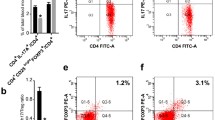Abstract
Most of the findings have focused on the importance of CD4+HLA-G+ and CD8+HLA-G+ regulatory T cells (Treg) during pregnancy. It has been demonstrated that these HLA-G+ T cell subsets could induce maternal immune tolerance against semi-allogenic conceptus during pregnancy. There are only a few experiments regarding the Treg cells in the context of unexplained infertility (UI). Thirty-five participants including 18 primary unexplained infertile and 17 fertile females were enrolled in this study. A total of 3–5 ml blood samples were taken, and peripheral blood mononuclear cells (PBMCs) were separated by using Ficoll. Using a flow cytometer, the frequency of CD4+HLA-G+ and CD8+ HLA-G+ T cells was assessed in the peripheral blood samples of primary unexplained infertile and fertile females. Our results showed that the frequency of CD8+HLA-G+ Treg cells was significantly lower in primary unexplained infertile females than fertile females (P = 0.048). Although the frequency of CD4+HLA-G+ Treg cells in the primary unexplained infertile females was lower than fertile females, the difference was not statistically significant (P = 0.25). Regarding the important role of CD8+HLA-G+ Treg cells during pregnancy and its decrease in females with primary UI, it seems that reduced CD8+ HLA-G+ Treg cells could be a leading immunological factor in the context of infertility. Nevertheless, more researches are needed in this field.


Similar content being viewed by others
References
Ehsani M, Mohammadnia-Afrouzi M, Mirzakhani M, Esmaeilzadeh S, Shahbazi M. Female unexplained infertility: a disease with imbalanced adaptive immunity. J Hum Reprod Sci. 2019;12:274–82.
Jasper MJ, Tremellen KP, Robertson SA. Primary unexplained infertility is associated with reduced expression of the T-regulatory cell transcription factor Foxp3 in endometrial tissue. Mol Hum Reprod. 2006;12:301–8.
Ozkan ZS, Deveci D, Kumbak B, Simsek M, Ilhan F, Sekercioglu S, et al. What is the impact of Th1/Th2 ratio, SOCS3, IL17, and IL35 levels in unexplained infertility? J Reprod Immunol. 2014;103:53–8.
Carosella ED, Favier B, Rouas-Freiss N, Moreau P, Lemaoult J. Beyond the increasing complexity of the immunomodulatory HLA-G molecule. Blood. 2008;111:4862–70.
Abediankenari S, Farzad F, Rahmani Z, Hashemi-Soteh MB. HLA-G5 and G7 isoforms in pregnant women. Iran J Allergy Asthm. 2015;14:217–21.
Hsu P, Santner-Nanan B, Joung S, Peek MJ, Nanan R. Expansion of CD4(+) HLA-G(+) T cell in human pregnancy is impaired in pre-eclampsia. Am J Reprod Immunol. 2014;71:217–28.
Carosella ED, Gregori S, LeMaoult J. The tolerogenic interplay(s) among HLA-G, myeloid APCs, and regulatory cells. Blood. 2011;118:6499–505.
Zare M, Namavar Jahromi B, Gharesi-Fard B. Analysis of the frequencies and functions of CD4(+)CD25(+)CD127(low/neg), CD4(+)HLA-G(+), and CD8(+)HLA-G(+) regulatory T cells in pre-eclampsia. J Reprod Immunol. 2019;133:43–51.
Feger U, Tolosa E, Huang YH, Waschbisch A, Biedermann T, Melms A, et al. HLA-G expression defines a novel regulatory T-cell subset present in human peripheral blood and sites of inflammation. Blood. 2007;110:568–77.
Shao L, Jacobs AR, Johnson VV, Mayer L. Activation of CD8+ regulatory T cells by human placental trophoblasts. J Immunol. 2005;174:7539–47.
Tilburgs T, Roelen DL, van der Mast BJ, van Schip JJ, Kleijburg C, de Groot-Swings GM, et al. Differential distribution of CD4(+)CD25(bright) and CD8(+)CD28(−) T-cells in decidua and maternal blood during human pregnancy. Placenta. 2006;27(Suppl A):S47–53.
Vianna P, Mondadori AG, Bauer ME, Dornfeld D, Chies JA. HLA-G and CD8+ regulatory T cells in the inflammatory environment of pre-eclampsia. Reproduction. 2016;152:741–51.
Hill JA, Faris HMP, Schiff I, Anderson DJ. Characterization of leukocyte subpopulations in the peritoneal fluid of women with endometriosis. Fertil Steril. 1988;50:216–22.
Steinborn A, Rebmann V, Scharf A, Sohn C, Grosse-Wilde H. Placental abruption is associated with decreased maternal plasma levels of soluble HLA-G. J Clin Immunol. 2003;23:307–14.
LeMaoult J, Krawice-Radanne I, Dausset J, Carosella ED. HLA-G1-expressing antigen-presenting cells induce immunosuppressive CD4+ T cells. Proc Natl Acad Sci U S A. 2004;101:7064–9.
Hu D, Chen Y, Zhang W, Wang H, Wang Z, Dong M. Alteration of peripheral CD4+CD25+ regulatory T lymphocytes in pregnancy and pre-eclampsia. Acta Obstet Gynecol Scand. 2008;87:190–4.
Paeschke S, Chen F, Horn N, Fotopoulou C, Zambon-Bertoja A, Sollwedel A, et al. Pre-eclampsia is not associated with changes in the levels of regulatory T cells in peripheral blood. Am J Reprod Immunol. 2005;54:384–9.
Sasaki Y, Darmochwal-Kolarz D, Suzuki D, Sakai M, Ito M, Shima T, et al. Proportion of peripheral blood and decidual CD4(+) CD25(bright) regulatory T cells in pre-eclampsia. Clin Exp Immunol. 2007;149:139–45.
Prins JR, Boelens HM, Heimweg J, Van der Heide S, Dubois AE, Van Oosterhout AJ, et al. Preeclampsia is associated with lower percentages of regulatory T cells in maternal blood. Hypertens Pregnancy. 2009;28:300–11.
Toldi G, Saito S, Shima T, Halmos A, Veresh Z, Vasarhelyi B Jr, et al. The frequency of peripheral blood CD4+ CD25high FoxP3+ and CD4+ CD25- FoxP3+ regulatory T cells in normal pregnancy and pre-eclampsia. Am J Reprod Immunol. 2012;68:175–80.
Amodio G, Mugione A, Sanchez AM, Vigano P, Candiani M, Somigliana E, et al. HLA-G expressing DC-10 and CD4(+) T cells accumulate in human decidua during pregnancy. Hum Immunol. 2013;74:406–11.
Funding
This study was financially supported by grantsfrom Babol University of Medical Sciences and Gerash University of Medical Sciences.
Author information
Authors and Affiliations
Contributions
The guarantor of integrity of entire study: MS; study concepts/study design: MS, MM, SE; data acquisition or data analysis/interpretation: all authors; manuscript drafting or manuscript revision for important intellectual content: MS, MM, ME; approval of the final version of the submitted manuscript: all authors.
Corresponding authors
Ethics declarations
Conflict of Interest
The authors declare that they have no conflict of interest.
Additional information
Publisher’s Note
Springer Nature remains neutral with regard to jurisdictional claims in published maps and institutional affiliations.
Rights and permissions
About this article
Cite this article
Ehsani, M., Mohammadnia-Afrouzi, M., Esmaeilzadeh, S. et al. Decreased Frequency of CD8+HLA-G+ T Cell in the Peripheral Blood of Primary Unexplained Infertile Females. Reprod. Sci. 28, 1939–1944 (2021). https://doi.org/10.1007/s43032-020-00431-z
Received:
Accepted:
Published:
Issue Date:
DOI: https://doi.org/10.1007/s43032-020-00431-z




